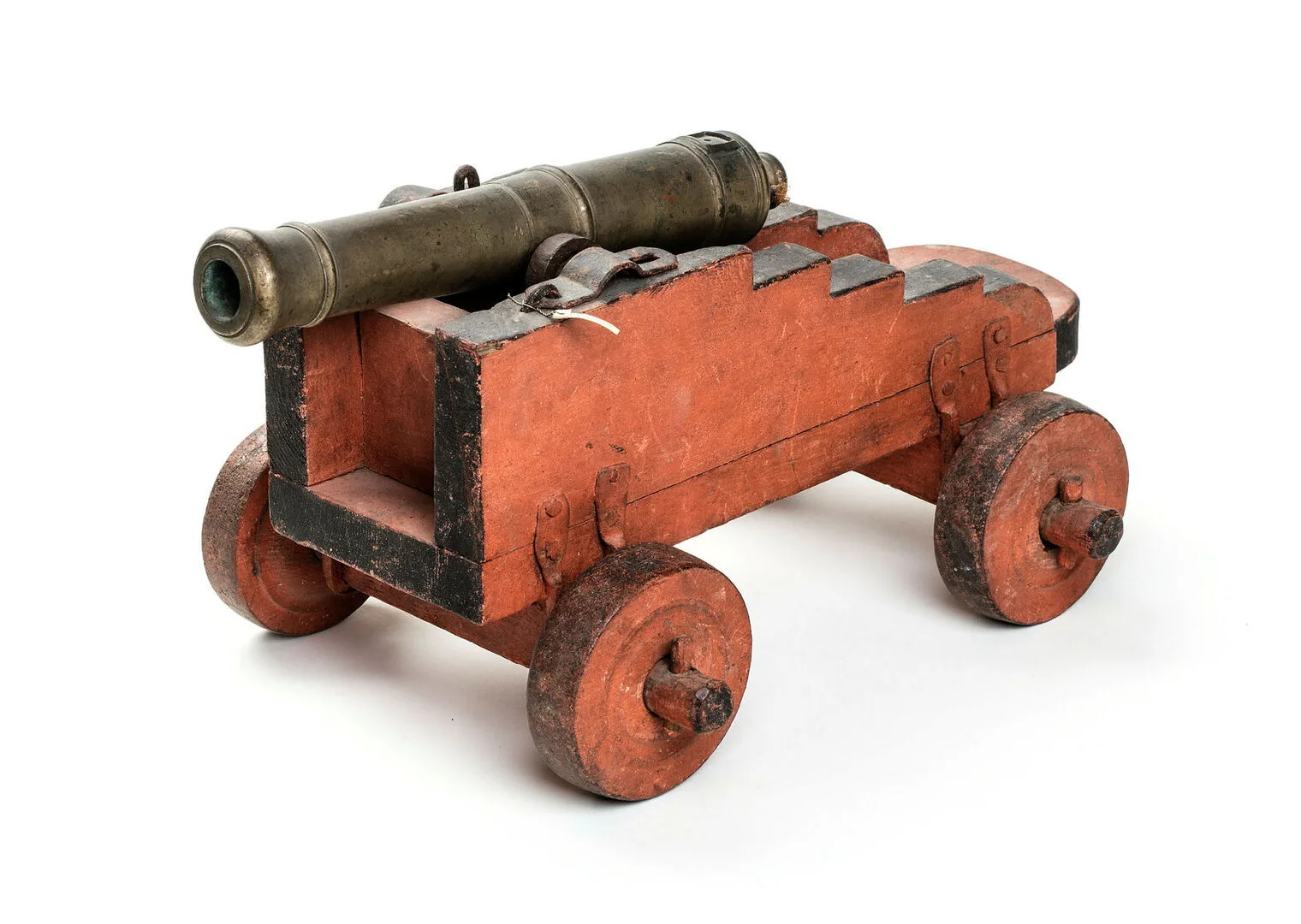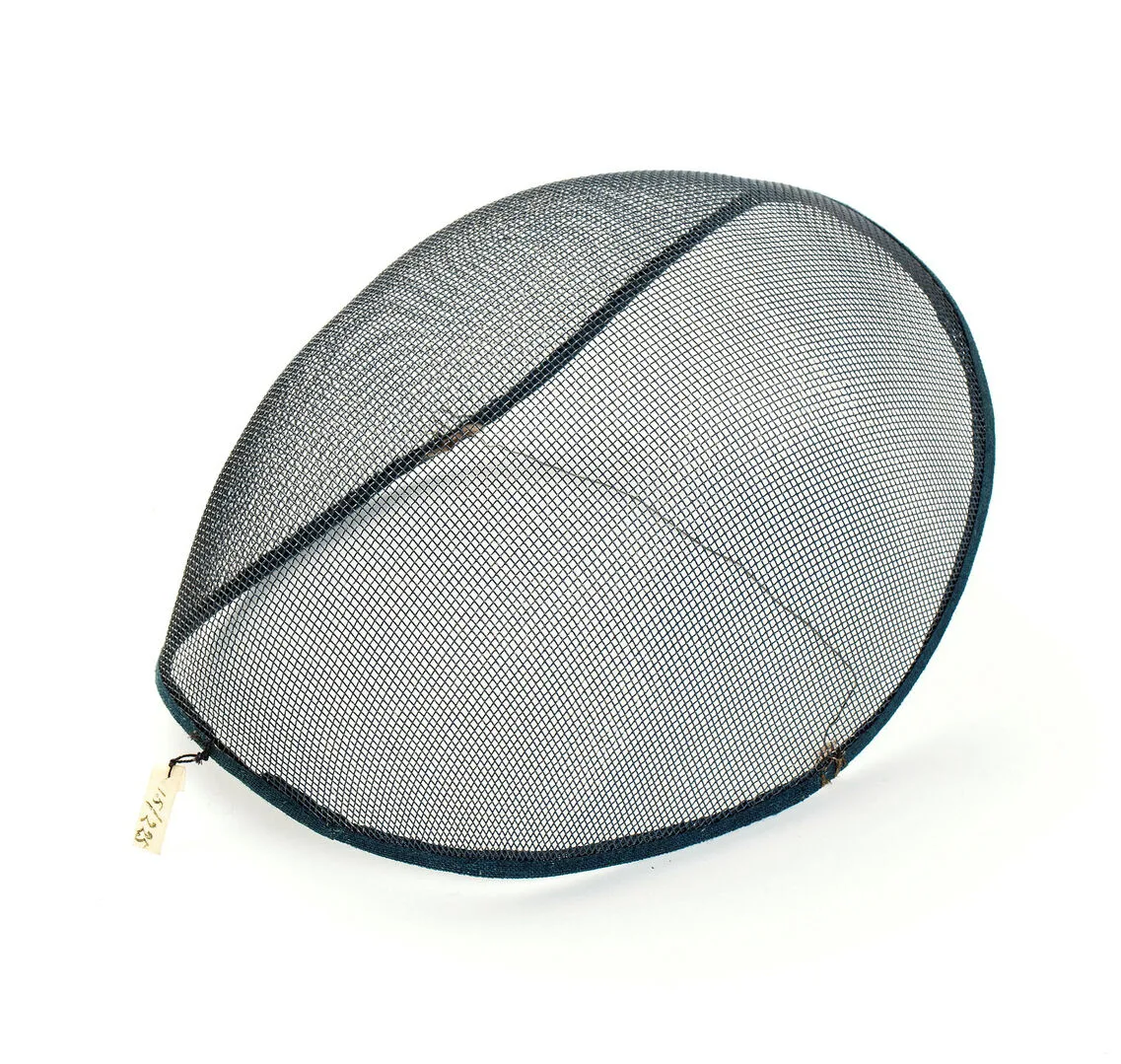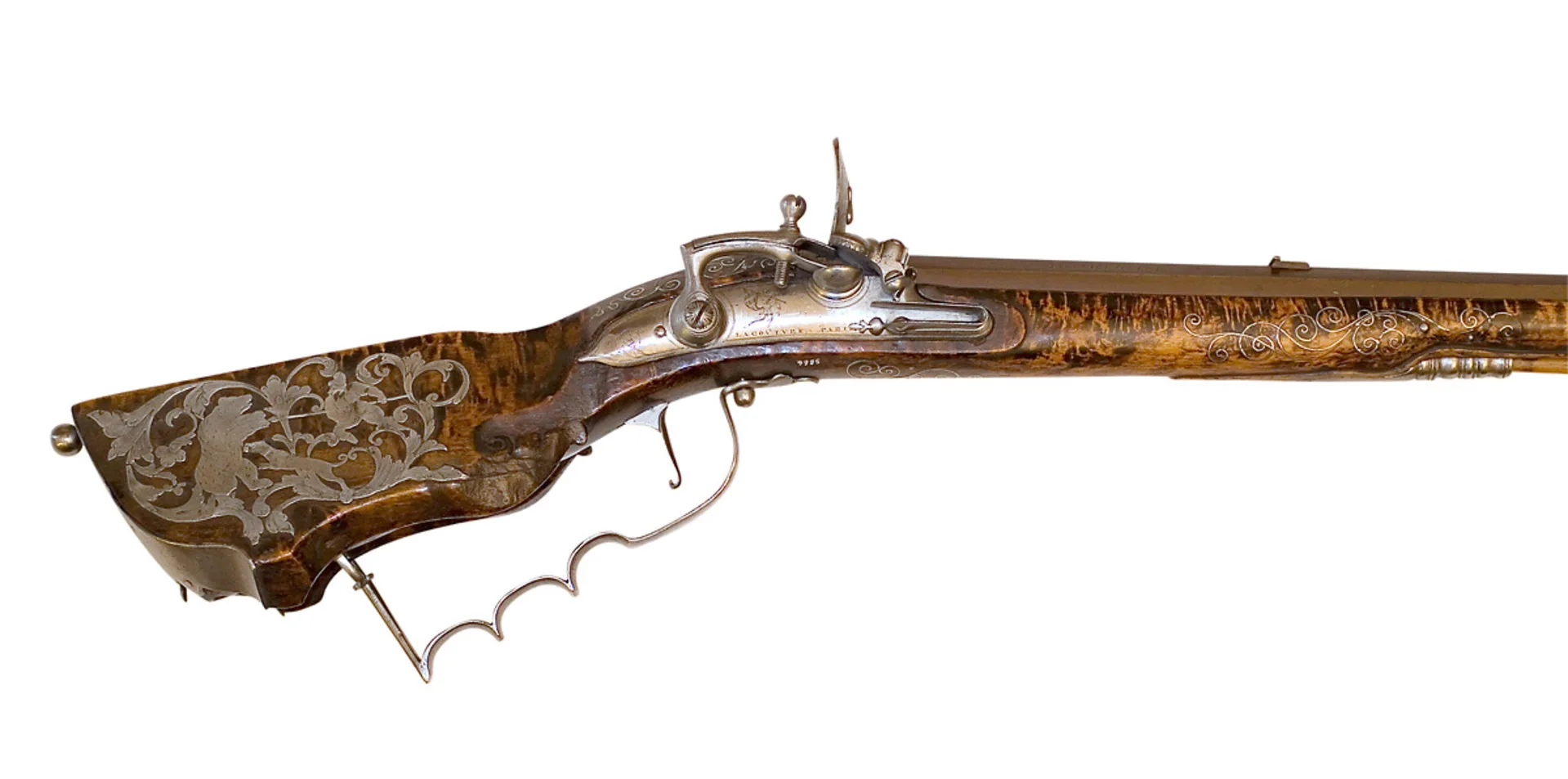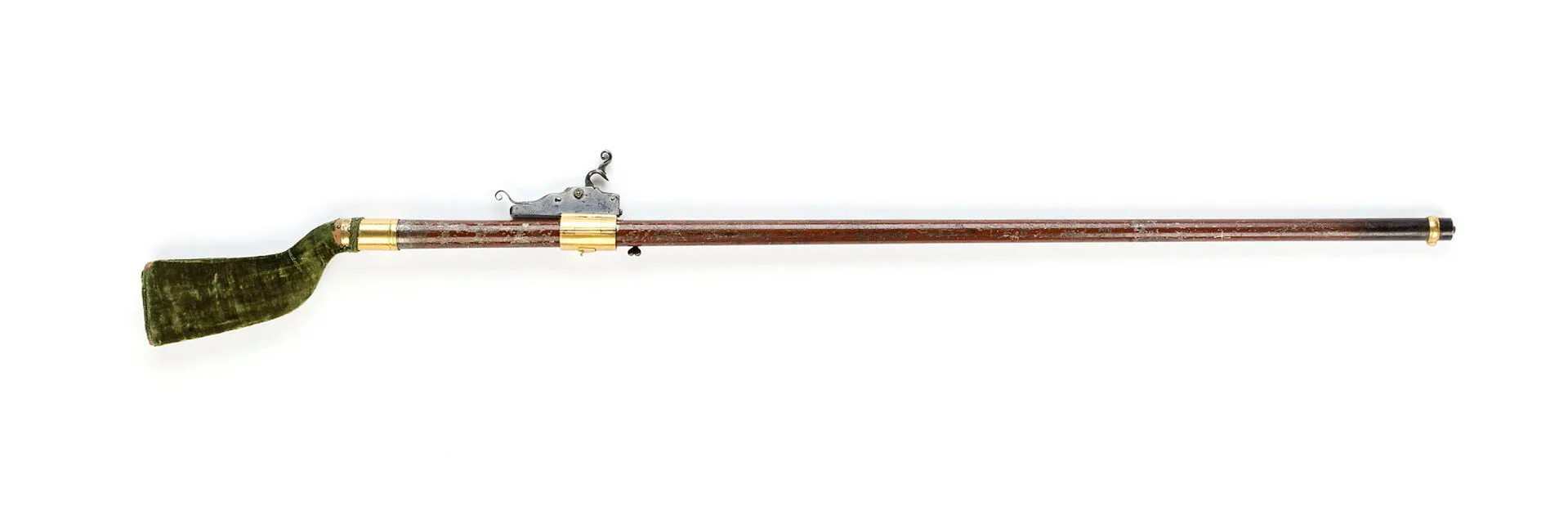The Tureholm Armoury
When the Royal Armoury moved to its current location in 1978, the Tureholm armory was installed in the museum. In 2018, in preparation for the construction of a new permanent exhibition, the armory was dismantled and is now stored in our archives. However, you can still experience it online.
The digital exhibition is not fully adapted for accessibility. If you have difficulty accessing the content via the link above, we have also gathered all the selected objects below.
An Armory for the Soul and Body
Part of the armory was a collection of curiosities, including both natural history objects and ethnographic artifacts. The collection reflects a broad knowledge and interest in the world, typical of the 18th century. Among the objects, we find taxidermy animals, peculiar items (such as a piece of an Egyptian sarcophagus), and oriental weapons.
The weapons collection was meant both to be admired and used. Some weapons were antiques even in the 18th century, while others were "modern" for their time. Some were hybrids of old and new; for instance, a gun barrel was sometimes mounted on a new stock and fitted with a new lock, extending its usability.

Painting, Trompe l’oeil, 1737
Still life, painted by Carl Hofverberg by commission from Count Ture Gabriel Bielke, showing a spruce panel with various objects tied with a red band.

Saluting Cannon
This saluting cannon, a miniature cannon with a naval carriage, features a bronze barrel with a darkened surface. The barrel has a circular cross-section, tapers forward, and ends with a flared muzzle. It is decorated with turned rings at the front, middle, and over the breech, along with a knop at the rear. Above the breech is a raised rectangular frame with a 2.5 mm vent hole. Beneath the barrel is a sturdy Y-shaped steel support, forged around the trunnions and resting on the carriage base.
The carriage is made of pine, painted red with black edges. It has a rectangular base with a rounded rear edge and stepped side panels connected by a lower front section. The wooden wheels are red with black edges and feature turned decorative rings. They are mounted on a robust wooden axle secured with U-shaped iron fittings. The trunnions are recessed into the side panels and locked with black steel fittings.

Miniature Cannon
The barrel is cast in dark steel, originally gold-painted with remnants remaining. It has a circular cross-section, tapering forward to a flared muzzle, with turned rings at the front, middle, and breech. A raised rectangular frame over the breech features a 2.5 mm vent hole and a brass plate inscribed “NB 1763” with “I:Lo.” The cylindrical supports and rear knop are prominent.
The carriage is made of red-painted pine with black edges, a rectangular base, and stepped side panels. The wooden wheels, painted red with black edges, are secured to a wooden axle with U-shaped iron fittings. The barrel is held in place with steel mounts.
Accessory: Red-painted wooden loading wedge, 190 mm long. Origin: Tureholm.

Part of a Sarcophagus, c. 1000 b.C.
Part of the lid, type Deir el Bahri, Egypt. Base of brown wood, rectangular, curved, flat ended. Motif with figures in red, blue and green. Translation of text fragment: “Singer in the Temple of Amun”.

Rostrum/Sword from a Swordfish, 1729
Label with Swedish text. Translation: “This rare fish, that wore this sword, was caught in Sweden, by the shore of Malmö, in the year 1729”.

Sturgeon (Acipenser sturio), 18th Century
Yellow-white skin of a sturgeon, dried in its natural shape. Partly sewn togeather with light thread, stuffing of tow.

Back Scratcher, 18th Century
Bent piece of wood of dark stained birch with turned handle ending in a ball. Underside flat and crosswise grooved. Top side slightly rounded and covered with inlay. Round the handle a pink (formerly red) silk band, now very worn and faded.

Five Pieces of Pottery, 18th Century
Five irregularly shaped sherds of ceramic, all of them with blue and white glaze. Largest sherd 110 mm, smallest 33 mm. Belongs to a group of miscellaneous objects found when dismantling the armoury in 1915. Older inv. nr 15:543 “Various wheels, handles, cranks, fragments of pottery, screws, pieces of metal, a pig’s tooth etc.”

Confetti Mask, possibly late 18th Century
Oval, convex mask of very thin steel wire forming a net. Rim of thicker steel wire, covered with blue cotton fabric. The mask is meant as face protection against the older form of confetti, such as candied almonds, nuts and coloured plaster balls.

Writing Desk, 18th Century
The desk was a place for studies, a place for the soul. The left hand side of the armoury contained books, scientific instruments and study samples from nature.

Socrates Calendar, 18th Century
A lead bust of Socrates placed on a pillar of Cuba mahogany. On the base a circular disc of brass with the days of the week engraved, behind it a rotatable disc with dates.

Runic Sword, 1752
Straight, double edged blade with 33 mm ricasso (unsharpened base of the blade). On one side the Bielke family crest with motto “Probantur Tempestate” (The Tempest will Test Them). On each side of the blade six groups of runes followed by prime numbers and celestial signs.

Heraldic Achievement, 1687
Decorative shield with the Bielke coat of arms with supporters and crest. Text: Count Niels Bielke, Anno 1687, 10th of December.

Double Sword from China, 1750’s
Brass fitted handle, short cross guard shaped as up-turned wings. Ornament of flowers (most likely a Lotus). Grip of wood clad with braided blue thread. Straight, double edged blade.

Armour Spike, 17th Century
Turkey. Possibly taken after the battle of Mohács 1687. Gilt silver grip engraved with flower pattern. Six rows of turquois stones. Inlay with turquois, jade and rubies set in gold. Blade of steel.
On view at Livrustkammaren in the exhibition Livrustkammaren nya basutställning 2018 (LRK bas)

Flintlock rifle
This flintlock rifle features an octagonal, browned barrel with eight grooves, made by Per Gustavsson in Kassmyra around 1660. On the left side of the breech is the stamp "P.G." The sights consist of a steel rear sight and a brass front sight, with a sighting groove between the tang screw hole and the rear sight. The barrel is secured with two loops, a tang screw, and two barrel pins.
The lock, made by Jonas Schertiger the Elder around 1715, has a flat lock plate with beveled edges and an engraved signature: "SCHERTIGER // STOCKHOLM." The cock is S-shaped and decorated with leaf motifs. The stock is made of walnut with carved vine ornamentation and fittings of steel and horn. The rifle includes a wooden ramrod with reinforced ends, one of which serves as a powder measure.

Flint Snaplock Rifle
This flint snaplock rifle features a browned steel barrel with eight grooves, marked with "H H S" and a royal orb on the breech, alongside the inscription "FRIDERICH MANGNUS STEINBOCK" on one side. The sights include a groove and a brass front sight. The barrel is secured with a tang screw and two barrel pins.
The lock is a snaplock of the springlock type, made by La Couture in Paris between 1660–1685, with engravings of a flower and a standard-bearer. The stock, made of birch, is decorated with carved leaf volutes, silver inlays, and motifs of bear hunting. The fittings are steel, and the butt plate features a support knob. The fore-end is partially damaged and missing some components. The rifle includes a wooden ramrod.

Air Gun, 18th Century
Barrel of brown painted steel with brass muzzle. Stock covered in green velvet. Lock of steel in shape of discs wherein cock, shaft, spring and trigger are fastened.

Flintlock rifle
Features an octagonal, browned barrel with eight grooves and decorations such as engraved zigzag lines, a mascaron, and a pinecone motif. The upper facet of the barrel bears a stamp reading "BEN // GT // MÅRD" and the engraving "A Jönkiöping." The sights include a rear sight with a vine motif and a spool-shaped brass front sight. The barrel is secured with a tang screw and three barrel pins.
The lock has a curved lock plate with engraved decorations, including trophy motifs and the signature: "B:MÅRD." The S-shaped cock is adorned with leaf designs. The wooden stock includes a cheek rest and an ammunition compartment, with brass fittings and carved details. The rifle is accompanied by a wooden ramrod, 761 mm long, with reinforced brass and steel ends.